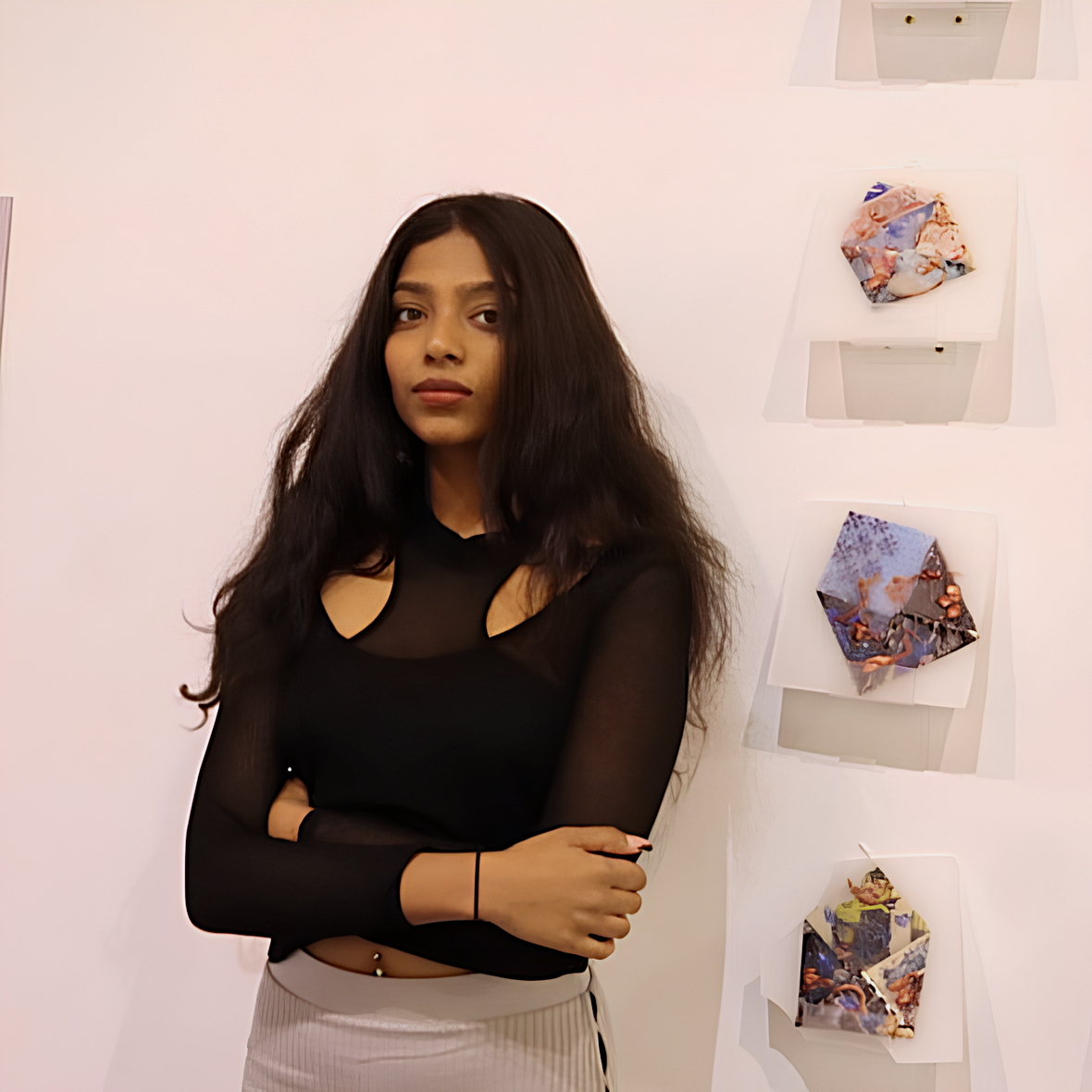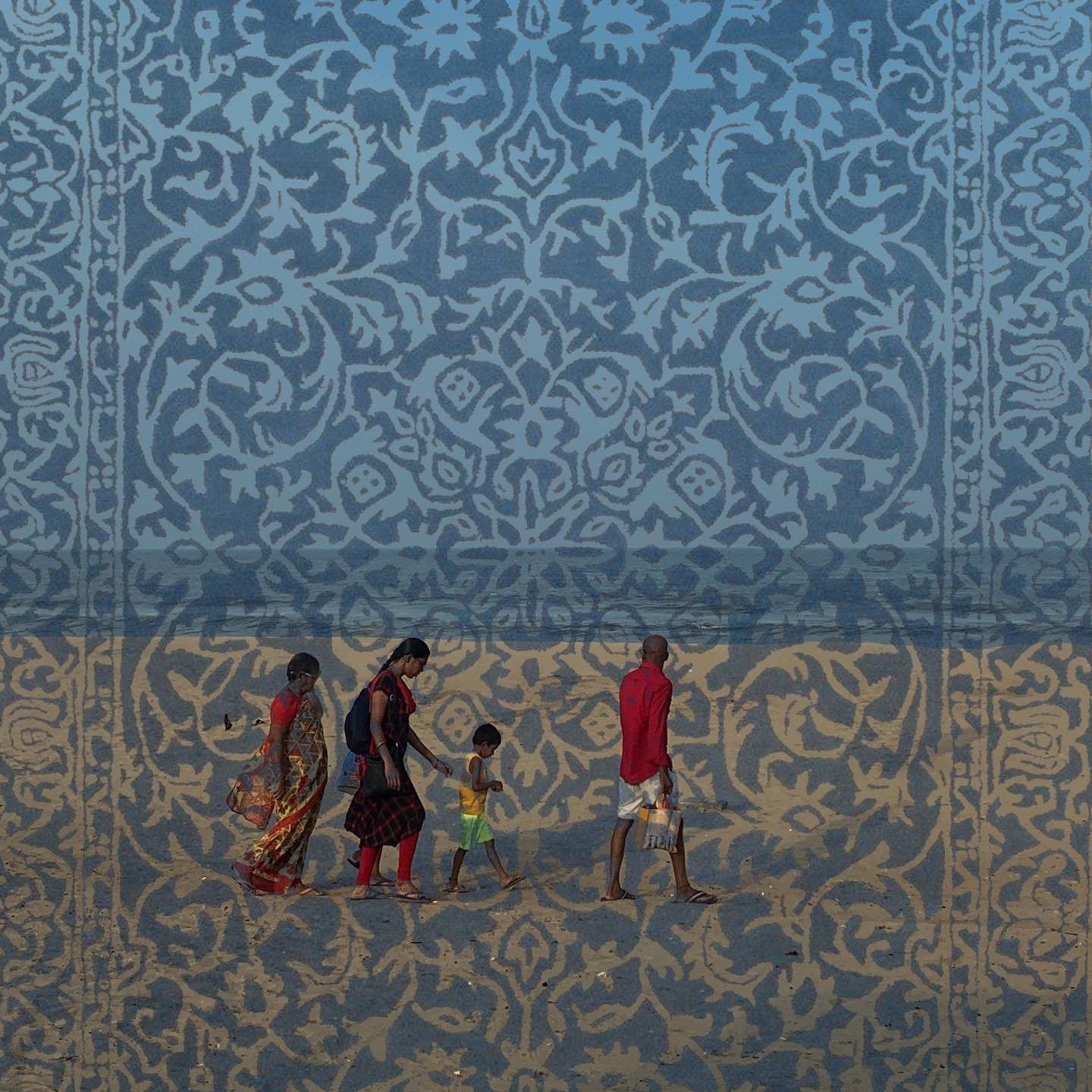Zehra Marikar
In a continually shifting and conflicted global landscape, where division and discrimination persist, Zehra Marikar endeavours to make works that resonate with a sense of familiarity, comfort, and belonging. Her artistic practice revolves around narratives exploring themes of identity, language, and ancestry. Engaging with diverse mediums, she envisions art not merely as static pieces adorning a wall but as a tangible bridge connecting the threads of the past to the tapestry of the present.
Zehra Marikar, 2023. Photo Courtesy: Zehra Marikar.
From a young age, Zehra Marikar found art to be a means of expressing herself when words failed. As one of triplets, the continual comparison to her two sisters instilled a desire for separation and individual identity. Art became Zehra's sanctuary, offering a space where she could authentically define herself. Born in Singapore, Zehra spent her infancy there. The ensuing eight formative years unfolded in Kerala, South India, the ancestral home of her father. Following that period, her family relocated to Chennai on the opposite coast, a place she would consider home for the next decade.
At the age of 18, Zehra embarked on her artistic journey, returning to Singapore to explore her connection to her birthplace. She underwent intensive training across multiple artistic mediums at LASALLE College of the Arts. However, she grappled with a sense of her art not being understood, expressing, "I thought I'd have this connection to the place I was born but somehow I didn't really feel like I fit in there, my art wasn’t understood by the people around me." In contrast to the vibrant energy of India, she found Singapore to be sterile and lacking in vitality. In pursuit of new adventures and a deeper understanding of different cultures, Zehra subsequently relocated to London, renowned for its multiculturalism, to pursue a Fine Arts degree at Camberwell College of Arts.
Zehra Marikar, Myself, 2021, Mixed Media. Photo Courtesy: Zehra Marikar.
Zehra Marikar, Familiar Objects, 2022, Digital Print. Photo Courtesy: Zehra Marikar.
Zehra's artistic inspiration emanates from personal experiences, family dynamics, and the nuances of daily life in India — ranging from vibrant advertising billboards and signs to the evocative scents of Jasmine in the air in Chennai. Her creative process involves capturing these moments through photography, transferring images onto canvas, and integrating elements such as textiles and patterns that carry sentimental value. Islamic and Indian patterns, drawn from a book on Indian textiles gifted by her mother, along with Bindi motifs, flower vines, and petals, are intricately woven into her work. These elements are often layered with personal family photos and archival images. Texture and scent play an integral role in her art as she strives to engage the viewer's sense of touch and smell, inviting a more visceral understanding of her work.
Zehra Marikar, Journey into the Centre of the World, 2023, Photography and Digital. Photo Courtesy: Zehra Marikar.
The recurrent appearance of blue and red hues in Zehra's art holds deep personal significance, evoking emotions of familiarity and comfort, along with memories from her time in India. She explains that she has always perceived blue as a warm colour, a notion that resonated with her after watching the film Blue is the Warmest Colour. This perception of warmth in blue stayed with her, especially when recalling the skies of India, where the blue felt like it surrounded her everywhere. This warm, enveloping sensation contrasts with the grey skies of London.
Zehra Marikar, Rooted in Zima Blue, 2021, Mixed Media. Photo Courtesy: Zehra Marikar.
In Rooted in Zima Blue, the two abstracted central figures represent Zehra's grandparents, while the smiling children on either side depict her mother and uncle. Created during a period when she was tracing her family history through ancestry research, the artwork unveiled a surprising revelation. She discovered that her family had migrated from Sri Lanka three generations prior, unravelling a previously unknown part of her identity.
The abstracted patterns in the artwork are drawn from the kind of tilework prevalent throughout India. Zehra aims to evoke a sense of familiarity, allowing viewers to immediately connect with associations to India. The Bindi motif, with its cultural and symbolic significance, becomes a symbol of cultural identity and personal connection in Zehra's work.
The title, Rooted in Zima Blue, is borrowed from an episode called Zima Blue in the show Love, Death and Robots. The episode revolves around the colour Zima blue, with a character striving to recreate it. Zehra, deeply inspired by this narrative, integrated the blue hues into her own artwork. The depiction of the blue seeping from the grandparents into the children reflects the concept that ancestry persists and unconsciously influences subsequent generations, mirroring the way the colour permeates beneath the four characters.
Zehra Marikar, Lost in Translation, 2022, Mixed Media. Photo Courtesy: Zehra Marikar.
During her time at Camberwell College of Arts, Zehra engaged in constant correspondence with her sister through emails. It was during this period that she encountered the series Letters from Home by Zarina Hashmi. In this series, Hashmi's sister wrote letters in Urdu, and Hashmi created woodcut and metal block prints from the original letters, preserving them as an archive of their communication. Zehra felt an immediate connection which prompted her to use her own sister's letters, drawn to the fact that her sister was a poet and a beautiful writer. Being part of triplets, they shared a profound bond, and Zehra expressed: "She is part of me, and the work is part of me." This inseparable connection led to the birth of the series Lost in Translation.
In this series, Zehra crafts envelopes from canvas, terracotta leaves, her sister's writings, and the scent of jasmine, all encased in wax. Jasmine represented the smell of home to Zehra, recounting “Everybody in Chennai wore jasmine flowers in their hair. When you're walking anywhere one of the most predominant smells is jasmine, whether that's in someone's house or in someone's hair or someone's body. I grew up smelling that smell and associating it with so many different feelings of safety and comfort.” The choice of wax, with its immediacy and domestic connotations, also drew Zehra to this material. The transparency and texture of wax were the perfect elements, as Zehra did not want things to be clear at first sight. She aimed for the viewer to uncover the layers of meaning one by one, avoiding immediate understanding.
Zehra Marikar, Lost in Translation, 2022, Mixed Media. Photo Courtesy: Zehra Marikar.
Zehra Marikar, Lost in Translation, 2022, Mixed Media. Photo Courtesy: Zehra Marikar.
This exploration of language and the immigrant experience led her to consider what it was like to move to a completely new place without knowing the language fully, feeling disconnected and having to assimilate into a culture that was not one's own. To understand this, she went on walking tours through Brick Lane and South Hall in London, both areas with a significant South Asian diaspora. This experience pushed her to research more about these communities and herself — reflecting on what it meant to be away from home and then trying to create a new one from scratch. She delved into understanding how this experience impacts one's thinking and communication.
Zehra Marikar, On My Way Home, 2023, Digital Print. Photo Courtesy: Zehra Marikar.
Since graduating, Zehra has embarked on collaborations, joining forces with her friend Yaska Sahara to establish the Home on Me Collective. This community-oriented project includes an accompanying podcast and aims to provide accessible art spaces for fellow artists. In a philanthropic endeavour, Zehra has also initiated The Empty Wall Project, an arts charity dedicated to providing free classes to teach colour theory, still life, charcoal drawing, and ceramics to young refugees. They are currently collaborating with the Afghan and Central Asian Association.
As Zehra's artistic journey evolves, her work stands as a poignant reflection of her personal experiences, the depth of emotions she explores, and her ongoing quest for connections in a world characterised by transitions and diverse inspirations.
To learn more about Zehra Marikar, follow her on Instagram or her website. To keep up to date with Home on Me follow them on Instagram or their website and The Empty Wall Project Instagram.
Selected Exhibitions:
Missed Letters, Making Space, London 2023
Home on Me, Hoxton Arches, Hoxton, London 2023
Deconstruct / Construct, Safehouse 1, Peckham, London 2022
ADA Slaight Gallery, OCAD, Toronto, Canada 2022
Decolonising the Museum, Arts SU Gallery, Camberwell, London 2022
Chiaroscuro, APT Gallery, Deptford, London 2022
Outside the Lines 3, Buva House, Chennai, India 2019
Outside the Lines 2, Lalit Kala Academy, Chennai, India, 2018
Outside the Lines 3, Humming Room, Chennai, India 2017
Annette Fernando
Emerging Artist Co-Editor, MADE IN BED










